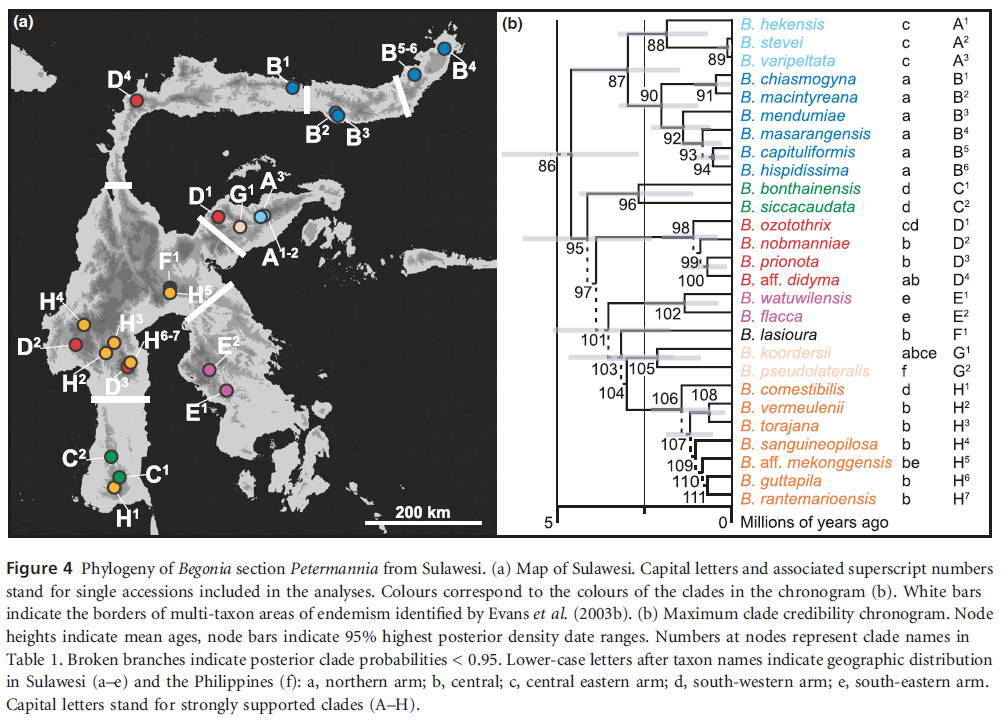Begonia torajana in Edinburgh J. Bot. 68(2): 246. 2011
Primary tabs

Diagnosis
- Begoniae imperfectae Irmsch. similis a qua staminibus multo magis numerosis (c.52-66 nec c.30) et tepalis florum masculorum multo majoribus (11-21 × 14-19 mm nec c.7 × 9 mm) differt. - Type: Indonesia, Sulawesi, Sulawesi Selatan, Gunung Sesean, 02°54'08.9S, 119°52'40.9E, 1819 m, 1 v 2009, D.C. Thomas & W.H. Ardi 09-106 (holo E; iso BO, L). (Thomas, D.C., Ardi, W.H. & Hughes, M., Nine new species of Begonia (Begoniaceae) from South and West Sulawesi, Indonesia in Edinburgh Journal of Botany 68(2). 2011)
Description
- Perennial, dioecious? herb, with erect stems, to c.150 cm tall, glabrous except for a sparse indumentum of microscopic, glandular hairs.
Stems branched; internodes c.4-21.5 cm long, reddish.
Leaves alternate; stipules caducous, 10-17 × 4-9 mm, ovate to oblong, with an abaxially prominent midrib that projects shortly at the apex; petioles 5.5-20 cm long, reddish; lamina 9.5-19.8 × 4.5-12 cm, basifixed, very asymmetric, ovate to elliptic, base cordate, lobes not or sometimes slightly overlapping, apex acuminate, margin biserrate, irregularly scalloped, teeth not bristlepointed, adaxial surface dark green and abaxial surface pale green, coriaceous, primary veins 4-5, actinodromous, secondary veins craspedodromous.
Inflorescences: female inflorescences 2-flowered, with 1-2 partial inflorescences at subsequent nodes, peduncles c.2-17 mm long; male inflorescences composed of 1-6 cymosesubumbellate partial inflorescences, each with 3-5 compressed monochasia with 3-5 flowers, peduncles 9-15 mm long.
Male flowers: pedicels c.18-20 mm long; tepals 2, whitish with pale pink veins or pinkish, 11-21 × 14-19 mm, broadly ovate to suborbicular, base cordate, apex rounded; androecium of c.52-66 stamens, yellow, filaments up to c.2 mm long, slightly fused at the base, anthers c.1-1.2 mm long, obovate, dehiscing through unilaterally positioned slits that are > 1/2 as long as the anther.
Female flowers: pedicels 6-8 mm long; tepals 5, white, subequal, 18-27 × 12-15 mm, elliptic, sometimes irregularly serrate at the apex; ovary ellipsoid, locules 3, placentation axile, placentae bilamellate, wings 3, triangular to crescent-shaped, subequal, base rounded, apex rounded or truncate, widest subapically, style basally shortly fused, 3-branched, each stylodium bifurcate in the stigmatic region, stigmatic surface a spirally twisted papillose band, yellow.
Fruiting pedicels up to c.6-9 mm long. Fruits slightly fleshy, ellipsoid, 15-20 × 5-7 mm (excluding the wings), indehiscent?, wing shape as for ovary, 8-10 mm wide at the widest point (in the middle part or at the apex of the ovary); seeds ellipsoidal, c.0.3-0.4 mm long, collar cells c.1/2-2/3 of the length of the seed. (Thomas, D.C., Ardi, W.H. & Hughes, M., Nine new species of Begonia (Begoniaceae) from South and West Sulawesi, Indonesia in Edinburgh Journal of Botany 68(2). 2011)
Habitat
- This is a rainforest floor species, growing on steep slopes between c.800 and 2000 m above sea level. Although this species grows best in full shade and moist conditions, it has a certain tolerance towards higher light intensities and can be found in disturbed habitats at roadsides dominated by Gleicheniaceae species.
Conservation
- Proposed IUCN conservation category: Least Concern (LC). All of the observed subpopulations were in areas which have no legal protection. The subpopulations on Gunung Sesean, where Begonia torajana is locally common, were restricted to pockets of primary forest surrounded by strongly disturbed habitats including large areas which were fire-cleared for cattle grazing. The subpopulations along the road from Rantepao to Palopo may ultimately fare better since they are in areas of extensive rainforest protected by mountainous terrain. The inaccessibility of the primary rainforests of the Rantepao-Palopo divide offers some natural protection. (Thomas, D.C., Ardi, W.H. & Hughes, M., Nine new species of Begonia (Begoniaceae) from South and West Sulawesi, Indonesia in Edinburgh Journal of Botany 68(2). 2011)
Distribution
Endemic to Indonesia, Sulawesi, South Sulawesi.
See Images for a distribution map, and specimen tab for map of point distribution data of georeferenced specimens.
See Images for a distribution map, and specimen tab for map of point distribution data of georeferenced specimens.
Etymology
- The specific epithet refers to the ethnic group of the Toraja and their traditional territory (Tanah Toraja in South Sulawesi), which covers the known distribution of Begonia torajana. (Thomas, D.C., Ardi, W.H. & Hughes, M., Nine new species of Begonia (Begoniaceae) from South and West Sulawesi, Indonesia in Edinburgh Journal of Botany 68(2). 2011)A
Notes
- Begonia torajana belongs to a group of closely related species which are characterised by putative dioecy, fleshy or semi-fleshy fruits, and succulent, leathery leaves (see notes under Begonia rantemarioensis). With regards to the leaf morphology and male inflorescence architecture it is similar to Begonia imperfecta, which is only known from the male type material. However, the tepals of the male flowers are much larger in Begonia torajana (11-21 × 14-19 mm) than in B. imperfecta (c.7 × 9 mm), and the androecium in B. torajana consists of c.52-66 stamens, while only c.30 stamens have been reported in Begonia imperfecta (Irmscher, 1914). (Thomas, D.C., Ardi, W.H. & Hughes, M., Nine new species of Begonia (Begoniaceae) from South and West Sulawesi, Indonesia in Edinburgh Journal of Botany 68(2). 2011)
Molecular Systematics
- see Thomas et al., 2012 (Thomas, D.C., Hughes, M., Phutthai, T., Ardi, W.H., Rajbhandary, S., Rubite, R., Twyford, A.D. & Richardson, J.E. 2012: West to east dispersal and subsequent rapid diversification of the mega-diverse genus Begonia (Begoniaceae) in the Malesian archipelago. – Journal of Biogeography 39: 98-113)
- GenBank
 |


